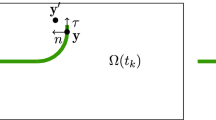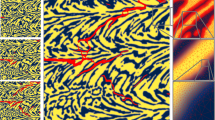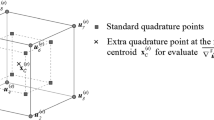Abstract
The phase field method is a versatile simulation framework for studying initiation and propagation of complex crack networks without dependence to the finite element mesh. In this paper, we discuss the influence of parameters in the method and provide experimental validations of crack initiation and propagation in plaster specimens. More specifically, we show by theoretical and experimental analyses that the regularization length should be interpreted as a material parameter, and identified experimentally as it. Qualitative and quantitative comparisons between numerical predictions and experimental data are provided. We show that the phase field method can predict accurately crack initiation and propagation in plaster specimens in compression with respect to experiments, when the material parameters, including the characteristic length are identified by other simple experimental tests.





















Similar content being viewed by others

References
Amor H, Marigo JJ, Maurini C (2009) Regularized formulation of the variational brittle fracture with unilateral contact: numerical experiments. J Mech Phys Solids 57(8):1209–1229
Baz̆ant Z, Belytschko T (1985) Wave propagation in strain-softening bar: exact solution. J Eng Mech 111:81–389
Baz̆ant Z, Pijaudier-Cabot G (1988) Nonlocal continuum damage, localization instability and convergence. J Appl Mech 55:521–539
Belytschko T, Black T (1999) Elastic crack growth in finite elements with minimal remeshing. Int J Numer Methods Eng 45:601–620
Benalla A, Marigo J-J (2007) Bifurcation and stability issues in gradient theories with softening. Model Simul Mater Sci 15(1):S283–S295
Bernard PE, Moës N, Chevaugeon N (2012) Damage growth modeling using the thick level set (TLS) approach: efficient discretization for quasi-static loadings. Comput Methods Appl Mech Eng 233:11–27
Borden MJ, Verhoosel CV, Scott MA, Hughes TJR, Landis CM (2012) A phase-field description of dynamic brittle fracture. Comput Methods Appl Mech Eng 217:77–95
Bourdin B (2007) Numerical implementation of the variational formulation for quasi-static brittle fracture. Interface Free Bound 9(3):411–430
Camacho G, Ortiz M (1996) Computational modelling of impact damage in brittle materials. Int J Solids Struct 33:2899–2938
Cazes F, Moës N (2015) Comparison of a phase-field model and of a thick level set model for brittle and quasi-brittle fracture. Int J Numer Methods Eng (in press)
Daux C, Moës N, Dolbow J, Belytschko T (2000) Arbitrary branched and intersecting cracks with the extended finite element method. Int J Numer Methods Eng 48:1741–1760
De Borst R, Sluys lJ, Muhlausanf HB, Pamin J (1993) Fundamental issues in finite element analysis of localization of deformation. Eng Comput 10:99–121
Eastgate LO, Sethna JP, Rauscher M, Cretegny T (2002) Fracture in mode i using a conserved phase-field model. Phys Rev E 65(3):036117
Francfort GA, Marigo JJ (1998) Revisiting brittle fracture as an energy minimization problem. J Mech Phys Solids 46(8):1319–1342
Hakim V, Karma A (2009) A continuum phase field model for fracture. J Mech Phys Solids 15(2):342–368
Hofacker M, Miehe C (2013) A phase field model of dynamic fracture: robust field updates for the analysis of complex crack patterns. Int J Numer Methods Eng 93(3):276–301
Kuhn C, Müller R (2010) A continuum phase field model for fracture. Eng Frac Mech 77(18):3625–3634
Kuhn C, Müller R (2014) Simulation of size effects by a phase field model for fracture. Theor Appl Mech Lett 4:051008
Kuhn C, Schlueter A, Müller R (2015) A phase-field description of dynamic brittle fracture. Comput Mater Sci 108:374–384
Lasry D, Belytschko T (1988) Localization limiters in transient problems. Int J Solids Struct 24:581–597
Leguillon D (2002) Strength or toughness? A criterion for crack onset at a notch. Eur J Mech A Solid 21(1):61–72
Li J, Zhang XB (2006) A criterion study for non-singular stress concentrations in brittle or quasi-brittle materials. Eng Frac Mech 73:505–523
Lorentz E, Benallal A (2005) Gradient constitutive relations: numerical aspects and application to gradient damage. Comput Methods Appl Mech Eng 194:5191–5220
Mary S, Vignollet J, de Borst R (2015) A numerical assessment of phase-field models for brittle and cohesive fracture: \(\Gamma \)-convergence and stress oscillations. Eur J Mech A Solids 52:72–84
Miehe C, Hofacker M, Welschinger F (2010) A phasefield model for rate-independent crack propagation: robust algorithmic implementation based on operator splits. Comput Methods Appl Mech 199:2765–2778
Miehe C, Welschinger F, Hofacker M (2010) Thermodynamically consistent phase-field models of fracture: variational principles and multi-field fe implementations. Int J Numer Methods Eng 83(10):1273–1311
Moës N, Dolbow J, Belytschko T (1999) A finite element method for crack growth without remeshing. Int J Numer Methods Eng 46:131–150
Nguyen TT, Yvonnet J, Zhu Q-Z, Bornert M, Chateau C (2015) A phase field method to simulate crack nucleation and propagation in strongly heterogeneous materials from direct imaging of their microstructure. Eng Fract Mech 139:18–39
Nguyen TT, Yvonnet J, Zhu Q-Z, Bornert M, Chateau C (2016) A phase-field method for computational modeling of interfacial damage interacting with crack propagation in realistic microstructures obtained by microtomography. Comput Methods Appl Mech Eng. doi:10.1016/j.cma.2015.10.007
Peerlings RHJ, de Borst R, Brekelmans WAM, de Vree HPJ (1996) Gradient-enhanced damage for quasi-brittle materials. Int J Numer Methods Eng 39(39):3391–3403
Pham K, Marigo J-J, Maurini C (2011) The issues of the uniqueness and the stability of the homogeneous response in uniaxial tests with gradient damage models. J Mech Phys Solids (6)
Pietruszczak S, Mroz S (1981) Finite element analysis of deformation of strain-softening materials. Int J Numer Methods Eng 17:327–334
Pijaudier-Cabot G, Baz̆ant Z (1987) Nonlocal damage theory. J Eng Mech 113:1512–1533
Romani R (2013) Rupture en compression des structures hétérogènes á base de materiaux quasi-fragiles. PhD thesis, Université Pierre et Marie Curie
Romani R, Bornert M, Leguillon D, Roy RL, Sab K (2015) Detection of crack onset in double cleavage drilled specimens of plaster under compression by digital image correlation-theoretical predictions based on a coupled criterion. Eur J Mech A Solid 51:172–182
Sammis CG, Ashby WF (1986) The failure of brittle porous solids under compressive stress states. Acta Metall 34(3):511–526
Spatschek R, Hartmann M, Brener E, Müller KH, Kassner K (2006) Phase field modeling of fast crack propagation. Phys Rev Lett 96(1):015502
Triantafyllidis N, Aifantis EC (1986) A gradient approach to localization of deformation: I. Hyperelastic materials. J Elast 16:225–237
Wong RHC, Lin P, Tang CA (2006) Experimental and numerical study on splitting failure of brittle solids containing single pore under uniaxial compression. Mech Mater 38:142–159
Xu X-P, Needleman A (1994) Numerical simulation of fast crack growth in brittle solids. J Mech Phys Solids 42(9):1397–1434
Zhou F, Molinari JF (2004) Dynamic crack propagation with cohesive elements: a methodology to address mesh dependency. Int J Numer Methods Eng 59:1–24
Acknowledgments
This work has benefited from a French government grant managed by ANR within the frame of the national program Investments for the Future ANR-11-LABX-022-01. The financial support of J. Yvonnet from IUF (Institut Universitaire de France) is gratefully acknowledged. We thank the support from the Federeation Francilienne de Mecanique to conduct the experimental program.
Author information
Authors and Affiliations
Corresponding author
Rights and permissions
About this article
Cite this article
Nguyen, T.T., Yvonnet, J., Bornert, M. et al. On the choice of parameters in the phase field method for simulating crack initiation with experimental validation. Int J Fract 197, 213–226 (2016). https://doi.org/10.1007/s10704-016-0082-1
Received:
Accepted:
Published:
Issue Date:
DOI: https://doi.org/10.1007/s10704-016-0082-1



